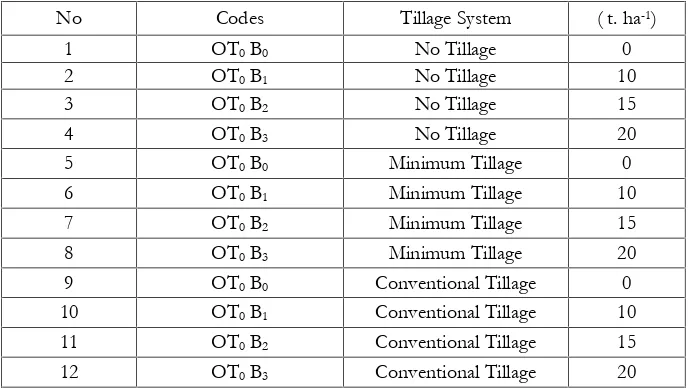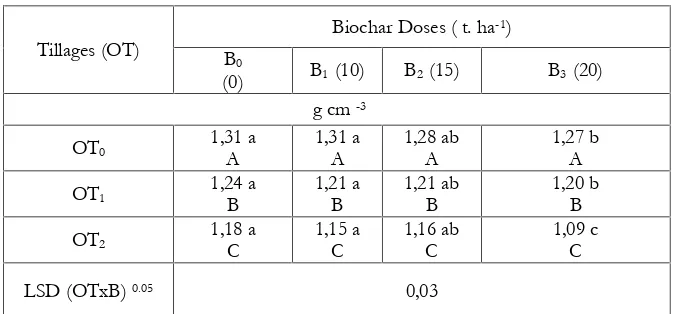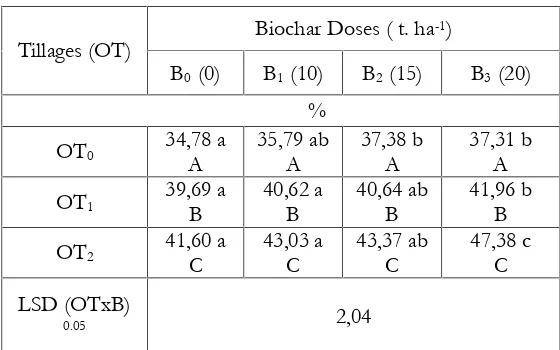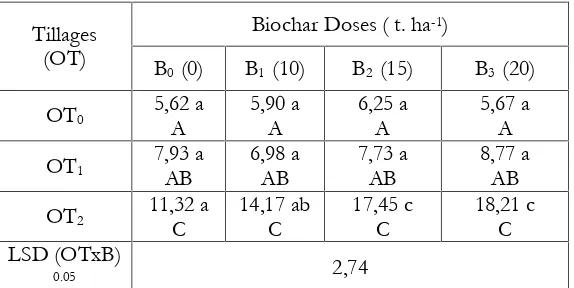Aceh International Journal of Science and Technology
ISSN: 2088-9860 eISSN: 2503-2348 Journal homepage:http://jurnal.unsyiah.ac.id/aijst
Biochar and Tillage Systems Influenced on Soil Physical Properties
Darusman2,3, Syahruddin1, Syakur2,and Manfarizah2
1)Graduate Student of Land Resources Conservation Study Program, Syiah Kuala University.
Darussalam. Banda Aceh
2)Lecturer. Faculty of Agriculture, Soil Science Department. Syiah Kuala University. Darussalam, Banda
Aceh
3)Corresponding Author: [email protected]
Received : June 04, 2017 Accepted : August 29, 2017 Online August 29, 2017
Abstract-Biochar is known as huge carbon storage in the soil. In the soil, biochar absorbs CO2from air
and keep them for hundred years. In addition to prevention, reducing emission and green house effects, Biochar also contributes to soil productivity such as physical and chemical property improvement of the soil. How biochar amends soil physical properties combined with some tillage systems are imperative to find out. This study aimed to determine the influence of biochar and tillage systems on some soil physical properties. Treatment arranged in a factorial randomized block design with three replications. The treatment of biochar effect consist of four levels; 0, 10, 15, and 20 t ha-1Biochar. The tillage systems were
three levels; no, minimum, and conventional tillage. The results showed that we found an interaction effect on the biochar application with tillage systems on dried bulk density, soil porosity, and soil permeability. No interaction was found on aggregate stability indexes and soil water holding capacity at water content at -0.3 and -15 bar of water potential (pF 2.54 and 4.2, accordingly). Biochar amounting of 10 t ha-1 combined with minimum tillage gave significant benefits on soil productivity in terms of dried
bulk density, porosity and soil permeability.
Keywords:Soil Physical Properties, Biochar and Tillage Systems .
Introduction
Biochar is known as huge carbon storage in the soil and remains there for up to hundred years. (Kuzyakov et al., 2009). It plays a key role in helping degraded land and in sequestering atmospheric carbon dioxide (Barrow, 2012). Therefore, black carbon (C) or more popularly called biochar (biomass charcoal) may overcome some limitations in carbon management and thus good soil amendments for improving soil quality (Sohiet al. 2010). Soil amendments meant the increasing of carbon content in the soil through manure and compost often successfully rehabilitate soil degradation, but many farmers experience difficulties obtaining them and may even cause serious groundwater contamination. Some farmers, therefore, in the countryside prefer to use Biochar traditionally to avoid ground water contamination. Various studies show, biochar has the potential to improve soil fertility and productivity. Herathet al. (2013) reported that agronomic benefits of applying biochar into the soil are mainly derived from the fertilizer value of biochar and its effect on the improvement of soil physical condition. Experts are attracted to study more biochar because it has general high porosity and large inner surface area, thus physical-chemical processes might be important for crop production.
soil structure and aeration due to its high porosity and low bulk density (Joseph et al., 2010), thereby providing favorable condition for nitrification.
Influence of biochar on soil aggregation has been reported by Fungo et al (2017). They found that biochar is stored predominantly as free particulate organic carbon in the silt and clay fraction and promote a movement of native soil organic carbon from larger-size aggregates to the smaller fraction in the short-term (2 years). They did not find entirely that biochar would consistently increase soil aggregation and did not observe a significant change in macro-aggregate C content. Busscher et al. (2010) found Biochar combined with swiftgrass affected aggregation, infiltration, and water holding capacity. Biochar applications increased volumetric water content at each matric potential tested although the effect was not always significant, however biochar may facilitate drainage in poorly drained soil (Herath et al. 2013). Influence of biochar combined with kinds of tillage system on soil quality or productivity has not been understood yet. Farmers, in practices, broadcast the biochar evenly top of the soil surface, and let them one-week prior planting.
Busari et al. (2015) found that conservation tillage involving zero tillage and minimum tillage aiming reducing the potensial soil breakdowns led to better soil environments and crop yield with the minimum impact on the enviroments. However Arthur et al. (2012) previously reported that physical practices of soils only slowly changed in response to cultivation practices like crop rotation and fertilisation; therefore they suggested that long-term field experiments are essential for assesments of the impact agriculture management. The more frequent tillage of agriculture field operation, the more potential soil structure is degraded if soil water content unnoticed (Darusman, 1991). Excessive of granules destruction may cause of soil granules becomes very smooth resulting the porosity becomes smaller, reduce soil aeration and drainage matters. These problems of soil caused by tillage operations could be prevented by applying biochar in suitable amount that the increase of soil bulk density could be avoided. The other benefit of biochar is reported by Barrow (2012) that biochar may reduce the need for fertilizer/ manure /compost and improve moisture retention thus reduce demand for irrigation and make cropping more secure.
The objective of this study was to find whether the provision of biochar and tillage systems might influence the soil physical properties. Our hypothesis was application of biochar and tillage system at field condition could affect soil physical properties such as bulk density, permeability, aggregate stability and water content at -0.33 bars and -15 bar of water potential.
Material and Methods
Field study was conducted at during Nov. 2014 till March 2015 on Ultisol soil in a community land of Jantho Baru village, Kota Jantho Sub district, Aceh Besar District of Aceh Province. The altitude of ± 250-300 m above sea level. A factorial Randomized Block Design consisting of two factors was used. The first factor is the tillage system (OT) consisting of three levels,: no tillage, minimum tillage, and conventional tillage and the second factor is the provision of biochar (B) consist of four levels: 0, 10, 15, and 20 t ha-1of biochar.
Table 1. Composition of the combination of tillage systems and provision of biochar.
No Codes Tillage System ( t. ha-1)
1 OT0B0 No Tillage 0
2 OT0B1 No Tillage 10
3 OT0B2 No Tillage 15
4 OT0B3 No Tillage 20
5 OT0B0 Minimum Tillage 0
6 OT0B1 Minimum Tillage 10
7 OT0B2 Minimum Tillage 15
8 OT0B3 Minimum Tillage 20
9 OT0B0 Conventional Tillage 0
10 OT0B1 Conventional Tillage 10
11 OT0B2 Conventional Tillage 15
Amounting of 500 kg rice husks were used to produce biochar. N, P, K Starter fertilizer were injected into the soil until depth of 60 mm with spacing from the plant was 50 mm as much as 300 kg ha-1.
Irrigation applied twice a day depending water used. Corn (var. Pertiwi 3) was planted as a crop indicator. Soil samples taken before planting and after harvest at soil depth of 0-20 cm were brought to soil physic laboratory for physical properties analysis. Some physical parameters observed were (a) the stability aggregates index, (b) soil water holding capacity at water content at -0.3 and -15 bar of water potential (pF 2.54 and 4.2, accordingly) (c) dried bulk density, (d) soil porosity, (e) soil permeability.
Disturbed soil samples were collected from each plot, air-dried, and then stored until used. Soil aggregate stability was reported as aggregate stability index and determined using wet and dry sieving methods (Kemper and Rosenau, 1986). Average diameter soil aggregates from wet and dry sieving (instability index) was calculated as:
Aggregate stability index = 1/ instability index
Soil water holding capacity at water content at -0.3 and -15 bar of water potential (pF 2.54 and 4.2, accordingly) was determined by using a cellulose acetate membrane system. Gravimetric analysis was undertaken to determine the moisture content (g g-1). Dried soil bulk density was determined using
undisturbed ring sample techniques. Soil cores with diameter 50 mm and height 54 mm were pushed into a soil depth 100 mm. Total porosity was measured as the volume equivalent calculated using a soil particle density of 2.65 g cm-3. Soil permeability was measured using a constant head permeameter and reported as
cm hr-1.0
The statistical difference between the treatments was determined by analysis of variance (ANOVA) using SPSS software v. 1.7. The least significant difference within treatment atP= 0.05 was employed.
Result and Discussion
1. Soil Aggregate Stability Index
Analyses of variance (ANOVA) for aggregate stability index showed both treatments of biochar and tillage system independently influenced aggregate stability at P- level 0.05. Combination treatment of Biochar and tillage did show any influence on the aggregate stability (no interaction found). Means soil aggregate stability influenced by applying biochar and tillage system is given in Table 2. In general, the result showed that provision of biochar and tillage system reduced soil aggregate stability index. Amount of biochar of 10 t ha-1 has lowered aggregate stability even though not significantly. Apply conventional
tillage lowered the stability of aggregate significantly. He et al. (2016) reported that biochar may greatly influence aggregate stability due to its low bulk density. Frequent land cultivation may cause soil particles dispersed and creation of soil aggregate that a function of biological activity and time is disturbed (Herath
et al., 2013).
Table 2. Means of soil aggregate stabilityindex influenced by combination of tillage and of biochar
Tillages (OT) Biochar Doses ( t. ha
-1) Means
LSD0.05
= 4,75 B0 (0) B1(10) B2(15) B3(20)
OT0 67,80 64,29 58,13 53,37 60,90 C
OT1 66,22 60,52 57,08 57,63 60,36 B
OT2 57,07 53,37 57,83 53,31 55,40 A
Means LSD0.05
= 5,48
63,70 b
59,39 b
57,68 ab
54,77 a
Note: Number followed by the same letter was significantly different by LSD test at the P = 0.05 level. Small letters are read horizontally and capital ones read vertically
2. Soil Water Holding Capacity at Water Content at -0.3 and -15 bar of water potential
the conventional tillage can cause a decreasing of soil water content at the point permanent wilting (pF 4.2).
Table 3. Means of soil water content at -0.3 bar (pF 2.54), and -0.15 bar (pF 4.2) of water potential influenced by Tillage
Note: OT0(without tillage), OT1(minimum tillage) and OT2(conventional tillage). Number followed by
the difference letter was not significantly different at LSD test. P
Table 3 shows the water content in lowest field capacity occurred in minimum tillage indicated by the water content at pF 2.54 amounted to 22.36% and the highest water content occurred on no tillage that is amounted to 25.16%. Tillage operation influenced the amount of water hold in the soil. Seems that this type of soil was rather structure less, thus once it is tilled, and the pores that hold water become disturbed and less. Lal and Shukla (2004) stated that soil water content at -0.3 bar of water potential or pF 2.54 is the upper limit of moisture content that a soil can hold. It is the moisture content when all macro pores or transmission pores have been drained and water in the macrospores has been replaced by air. There are numerous soil factors that affect water content at pF 2.54. Important among these are texture and especially the clay content, clay minerals, porosity and pore size distribution, and soil organic matter content.
Soil Water Content at -15 bar of water potential (pF 4.2) is also named as the lower limit of the moisture content of soil at which forces of cohesion and adhesion holding moisture in soil far exceed the pull that plant roots can exert to extract moisture from the soil (Hillel, 1982). This is the moisture content at which plant leaves wilt permanently and do not regain turgidity even when placed in an atmosphere with a relative humidity of 100%. Similar to water content at pF 2.54, the water content also differs widely among soils. In contrast to water content at pF2.54, this water content is not significantly influenced by aggregation, structural porosity, and soil organic matter content (Lal and Shukla, 2004).
3. Dried-Bulk Density
The means of dried bulk density (Table 4) due to the influence of combination treatments of Tillage system and Biochar showed significantly different atP-level 0.05.
Table 4. Means of bulk density influenced by combination of tillage and of biochar
Tillages (OT)
Note OT0(without tillage), OT1(minimum tillage) and OT2(conventional tillage). Number followed by the
Table 4 shows that we found a very significant interaction between tillage systems with provision of biochar on soil bulk density. The highest bulk density found on no-tillage and no biochar (0 t ha-1) is 1.31
g cm-1 while the lowest bulk density found on interaction between conventional tillage and 20 t ha-1 of
biochar is equal to 1.09 g cm-3. Busariet al(2015) stated that np tillage involves land cutivation with kittle
or no soil surface disturbance, the only disturbance being during planting. While minimum tillage tillage means reduced level of soil manipulation involving ploughing using primary tillage implements. In accordance with Hakimet al.(1986) tillage can reduce the bulk density and particle density in a certain type of land. So that the roots plant can penetrate the soil so well and the plants can thrive, either on the annual land and production land. Moreover applying biochar may greatly improve soil structure and aeration due to its high porosity and low bulk density (Joseph et al. 2010). However, lower bulk density is not appropriate for crop development because roots needs matrix to stand. Therefore, applying 10 t ha-1
of biochar and combined with minimum tillage is economically effective to reduce bulk density for crop productivity.
4. Soil Porosity
Lal and Shukla (2004) define porosity is a general term used to designate all voids in the soil. Total porosity (ft) is usually determined from the bulk density and particle density relationship (ft= 1 b/ s).
But, total porosity can also be determined from the saturation moisture content ( s), provided that there is no entrapped air. These relationships hold for non- swelling soils. Soil porosity or pore space is the portion of soil bulk volume occupied by soil pores. The pores are filled with air/ and or water (Kirkham, 2014). Thus, porosity is affected by the bulk density and particle density of the soil. Lower bulk density, the higher porosity of the soil. In our research, soil porosity was calculated from the saturation moisture content (0 bar of water potential). Means of soil porosity affected by tillage and application of biochar is shown in Table 4.
Table 5 shows that we found significant influence of applying biochar combined tillage system (Interaction) on soil porosity. We found similar as the result of bulk density namely applying 10 ha-1
combined with minimum tillage economically and significantly result good in soil pores. Applying biochar, which has lower bulk density, surely decreases soil porosity. Minimum tillage reduces the breakdown soil aggregate too much by tillage operations.
Table 5. Means of soil porosity influenced by combination of tillage and of biochar
Tillages (OT) Biochar Doses ( t. ha
-1)
Note.: Number followed by the difference letter was not significantly different at 0,05 LSD test.
5. Soil Permeability
Table 6 shows that interactions combination treatments between tillage systems and biochar provision on soil permeability. We found conventional tillage gave much higher values at any given biochar application. However at any tillage system, then applying 10 t ha-1 results the increase soil permeability.
In the light soil productivity we conclude that treatment combination of applying 10 t ha -1and minimum
tillage economically better.
Table 6. Means of soil permeability influenced by tillage and of biochar
Tillages
Note.: OT0(without tillage), OT1(minimum tillage) and OT2(conventional tillage). Number followed by
the difference letter was not significantly different at 0,05 LSD test.
Darusman (1991) stated that there is correlation with bulk density decreasing and the increasing in total of soil porosity, where due to the severe decline in bulk density and an increasing in total of soil porosity causes the increasing of the soil permeability. This is presumably due to decreasing of bulk density and increasing total of soil porosity. According to Hillel (1982) that soil physic properties that effected soil permeability such as soil water content, bulk density, total porosity, fast pore drainage, slow pore drainage, coarse sand content, fine sand content, silt content and clay content. However Busariet al
(2015) said that effects of conservation tillage on soil properties vary, and these variations depend on the particular system chosen. Anikwe and Ubochi (2007) in Busariet al(2015) stated that no-till (NT) systems, which maintain high surface soil coverage, have resulted in significant change in soil properties, especially in the upper few centimeters. Furthermore Lal (1997) said that No tilllage of conservation parctices are generally more favourable in compare to tillage-based systems.
Conclusions
Tillage implementation and biochar aplication infulenced independently the aggregate stability index. However Soil water holding capacity at 2.54 pF and 4.2 pF was affected by minimum and conventional tillage. Treatment combination interaction significantly influenced dry bulk density, porosity, and permeability of the soil. Biochar amounting 10 t ha-1 combined with minimum tillage gave significant
benefits on soil productivity.
References:
Arthur. E, P. Schjonning, P. Moldrup, M. Tuller, and L.W. de Jonge. 2012. Density and permeability of a loess soil: Long term organic matter effect and the response to compressive stress. Geoderma 193-194 (2013) 236-245.http://dx.doi.org/10.1016/j.geoderma.2012.09.001.
Barrow, C.J. 2012. Biochar: Potential for countering land degradation and improving agriculture. Applied Geography 34.21-28.https://doi.org/10.1016/j.apgeog.2011.09.008
Busari, M.A., S.S. Kukal, A. Kaur, R. Bhatt, and A.A. Dulazi. 2015. Conservation tillage impacts on soil, crop and the environment. Intternational soil and water conservation research. 3 (2015) pp.
Busscher, W.J., J.M. Novak, D.E. Evans, D.W. Watts, M.A.S. Niandou, M. Ahmedna. 2010. Influence of pecan biochar on physical properties of a Norfolk loamy sand. Soil Sci., 175, pp. 10 14
http://dx.doi.org/10.1097/SS.0b013e3181cb7f46
Darusman, L.R. Stone, D.A. Whitney, K.A. Janssen, and J.H. Long. 1991. Soil properties after twenty years of fertilization with different nitrogen sources. Soil Sci. Soc. Am. J. 55:1097-1100.
Fungo, B., J. Lehmann, K. Kalbitz, M. Thion o, I. Okeyo, M. Tenywa, H. Neufeldt. 2017. Aggregate size distribution in a biochar-amended tropical Ultisol under conventional hand-hoe tillage.Soil and tillage. Vol 165, January 2017, Pages 190 197. https://doi.org/10.1016/j.still.2016.08.012
Hakim, N. M. Y, Nyakpa, A. M, Lubis, S. E, Nugroho, M. R, Saul, M. A, Diha, Go Ban Hong dan H. H, Bailey. 1986. DasarDasar Ilmu Tanah. Universitas Lampung. Bandar Lampung.
He L., X. Zhao, S.Q. Wang, G.X. Xing. 2016. The effects of rice-straw biochar addition on nitrification activity and nitrous oxide emissions in two oxisols. Soil & Tillage Research 164. 52-62.
https://doi.org/10.1016/j.still.2016.05.006
Herath, H,M,S.K., M. Camps-Arbestain, M. Hedley. 2013. Effect of biochar on soil physical properties in two contrasting soils: an Alfisol and an Andisol. Geoderma, 209 210, pp. 188 197
http://dx.doi.org/10.1016/j.geoderma.2013.06.016
Hillel, D. 1982. Introduction to soil physics. Academic Press. New York. London
Joseph, S.D., M. Camps-Arbestain, Y. Lin, P. Munroe, C.H. Chia, J. Hook, L. van Zwieten, S. Kimber, A. Cowie, B.P. Singh, J. Lehmann, N.Foidl, R.J. Smernik, and J,E. Amonette. 2010. An Investigation into the reactions of Biochar in soil. Soil Res. 48, 501-515.
Kemper, W.D., and R.C. Rosenau. 1986. Aggregate stability and size distribution. P. 425-442.In. A. Klute (ed.) Methods of soil analysis. Part 1. 2nded. Agron. Monograph. 9. ASA and SSSA,
Madison, WI.
Kirkham, M.B. 2014. Principles of soil and plant water relations. 2nd. ISBN 978-0-12-420022-7. Elsevier,
Academic Press.
Kuzyakov, Y., I. Subbotina, H. Chen, I. Bogomolova, X. Xu. 2009. Black carbon decomposition and incorporation into soil microbial biomass estimated byC-14 labeling. Soil Biol. Biochem., 41, pp. 210 219.
LAL, R. 1997. Long terms tillage and maize monoculture effects on a tropical alfisol in western nigeria. I. Crop yield and soil physical properties. Soil & Tillage Research 42, 1445-160.
https://doi.org/10.1016/S0167-1987(97)00006-8
Lal, R., and M. Shukla. 2004. Principles of soil physics. Marcel Dekker, Inc. New York. Basel.




